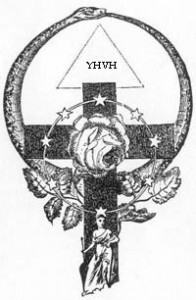Higgins, Sloane, Vaughan, and many other early writers asserted that Freemasonry sprang out of Rosicrucianism. Their statements have been seized upon by modern charlatans as a basis for preposterous claims. The early writers meant no such thing.
The symbolism of Rosicrucianism is derived from a Hermetic philosophy; that of Freemasonry from an Operative Art. In the middle of the eighteenth century all sorts of degrees were being invented, a Masonic rite was formulated which assumed the name of Rose Croix Masonry, now a part of the Ancient Accepted Scottish Rite. It adopted the symbol of the Cross and Rose. This was a coincidence, NOT a consequence. They had and have nothing in common with the Rosicrucians except the name and symbol. Here the connection ends, and a Rose Croix Mason and a Rosicrucian are two entirely different persons.
Rosicrucians have a number of symbols, some of them in common with Masonry, some peculiar to themselves. The principal ones were the Globe, Circle, Compasses, Square (both working tool and geometric figure), Triangle, Level, and Plummet. In Masonry, some of these are interpreted as symbols of moral virtues. In Rosicrucianism as the properties of the Philosopher’s Stone. The 21st emblem of Michael Maier’s “Atlanta Fugiens” gives the following collection of the most important R.C. symbols.
“A Philosopher is measuring with a pair of compasses a circle which surmounts a triangle. The triangle encloses a square, within which is another circle, and inside the circle a nude man and woman, representing, it may be supposed, the first step of the experiment. Over all is this paragraph:
“Fac ex mare et femina circulum, inde quandragulum, hinc triangulum, fac circulum et habebis lapidem Philosophorum.”
Which is: “Make of man and woman a circle; thence a square; thence a triangle; form a circle, and you will have the Philosopher’s Stone.”
As to the etymology of the Name ROSICRUCIAN several derivations have come down to us.
Peter Gassendi first, (Exam. Phil. Fludd, Sect. 15), and then Mosheim (Hist. Eccles. iv, i) deduce it from two words ROS, (dew) and CRUX, (a cross) and thus define it. Dew according to the Alchemists was the most powerful of all substances to dissolve Gold, and the Cross according to them, was identical with the letters L.V.X., because the figure of a cross exhibits the three letters of the word. But the word LUX was referred to as the seed or menstruum of the Red Dragon, which was that crude and material Light, which, being properly concocted and digested, produces Gold. Hence, says Mosheim, a Rosicrucian is a Philosopher, who by means of DEW seeks for LIGHT, that is, for the substance of the Philosopher’s Stone.
Another derivation is from ROSE and CROSS in Christian symbolism. This is the interpretation taken by Rose Croix Masons, and does not therefore commit the Fraternity to a similar acceptance.
Again, some regard the ROSE as a symbol with the CROSS of the generative principle of Nature, a symbolism certainly held by the Ancient Philosophers.
Other literary archeologists have thought that the name was derived from the arms of Johann Andreas, which were a St. Andrew’s Cross between four roses.
Still another interpretation presented by searchers is, that the ROSE being a symbol of secrecy, and the CROSS, one of Light, the ROSE and the CROSS were intended to symbolize the secret of the true Light or Knowledge which the Rosicrucian Brotherhood were to give at the end of their Hundred Years silence.
Members of Metropolitan College of the Societas Rosicruciana in America are invited to give close attention to the Historical Lecture in the 0=0 and correlate these items. The ONLY OFFICIAL SYMBOL EVER USED BY THE ROSICRUCIAN BROTHERHOOD IS A SINGLE ROSE ON A PASSION CROSS.
Freemasonry certainly did NOT “spring” from Rosicrucianism. Yet in a perfectly legitimate way the Rosicrucian Fraternity was the parent of genuine Freemasonry. The Rosicrucians perpetuated from antiquity, both the Lesser and the Greater Mysteries. At a time when all arcane bodies suffered persecution, it assimilated the various contemporaneous craft guilds, principally of an operative character, invested them with a legitimate symbology and shaped the drama of the Temple Builders into a philosophic allegory. When freedom of thought and action was assured the gradual coalition of these guilds was attempted, and from this movement the modern phase of Freemasonry was evolved. Thus Rosicrucianism is what might be called the foster parent of Freemasonry, yet giving to Freemasonry, all the enhancement of the dignity of age and an illustrious and legitimate descent from antiquity. Space forbids further amplification, which a larger publication would call for.

